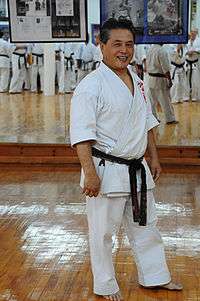Tadashi Nakamura (martial artist)
| Tadashi Nakamura | |
|---|---|
|
Tadashi Nakamura at Honbu, 2009 | |
| Born | February 22, 1942 |
| Style | Seidō juku Karate[1] |
| Teacher(s) | Ōyama Masutatsu |
Tadashi Nakamura (中村 忠 Nakamura Tadashi, born February 22, 1942) is the founder and Kaicho (chairman) of World Seidō Karate Organization.
Early years
Tadashi Nakamura was born on the February 22, 1942 in the town of Maoka on the island of Karafuto. Nakamura trained in various martial arts including Goju-Ryu, Kendo, and Kyokushin. In 1956 he started studying with Mas Oyama (founder of the Kyokushin style of karate) and he had reached the rank of shodan(1st degree black belt) on May 6, 1962.[2]
When he was 19 years old (1961) he made his first tournament appearance, the All-Japan Student Open Karate Championship, where he was placed first. In 1962, he took part in a match against a Muay Thai of the Lumpinee Boxing Stadium. The contest had been to determine which country had the 'best' martial art. He fought Muay Thai rule but in winning he became a Japanese national hero.
It was around this point in his life that Nakamura started passing his knowledge and experience onto others. Firstly at Camp Zama (a U.S. military base near Tokyo) from 1961 to 1965. He also coached the karate team for the Toho Medical University for three years. He also served as chief instructor at the Kyokushin Karate Honbu in Tokyo while earning his seventh dan.
Kyokushin
On April 5, 1966, the head of Kyokushin Karate, Masutatsu Oyama, selected Nakamura to go to the U.S.A. and spread the spirit of karate. Aged 24 he moved to New York to begin teaching Kyokushin Karate. His first dojo was at the Brooklyn Academy of Music. Over the next ten years he served as the American head of Kyokushin Karate. In 1971 he established the North American Kyokushin Karate headquarters on 14th St in Manhattan. He trained many students: Thomas Wiggins, Claude Battle, Charles Martin, William Best, Michael Reeves and William Oliver were some of his students.
As the Kyokushin style became more popular, Nakamura started to feel the quality of the instruction was slipping. He also began questioning the philosophy of his mentor Mas Oyama. In 1976 he respectfully withdrew from Kyokushin Karate, severed links with the Japanese Karate world and established his own style, Seidō juku.
Seido
Seido means 'Sincere Way' and aims to develop students not just physically but also mentally, helping create 'complete' and 'balanced' individuals committed to improving themselves and the communities they live in.
Seido karate's three main principles are Respect, Love and Obedience. Love for one's family and friends. Respect for your fellow karate ka, your seniors, your parents and their knowledge and experience. Obedience (not subservience) to the laws and moral rules of life. Seido is headquartered in New York City, but has many branch dojos around the world.[3]
An important part of the Seido World Seido Karate Organization is the Seido Juku Benefit Foundation which performs many good works for charity, including the annual benefit tournament. Nakamura has received praise and recognition from City, State, National and International leaders for the good works of the benefit foundation.
Books and articles
Nakamura has authored several books and articles on Seido Karate as well as related topics such as meditation, breathing, and teaching. Some of these include;
- One Day, One Lifetime (1995) (ISBN 0-8048-3064-9)
- The Human Face of Karate (1989) (ISBN 4-07-975055-2)
- Karate: Technique and Spirit (2001) (ISBN 0-8048-3282-X)
- Karate Kyohon (2001) (ISBN 4-07-231722-5)
See also
- Eiji Yasuda
- Kenji Kurosaki
- Masashi Ishibashi
- Hirofumi Okada
- Shigeru Oyama
- Yasuhiko Oyama
- Akio Fujihira (ring name Noboru Ohsawa)
- Hideyuki Ashihara
- Yuzo Goda
- Terutomo Yamazaki - trained together
Notes
- ↑ Vasquez, Emily (June 10, 2006). "After 30 Years, a Man's Vision for Karate Thrives as a Way of Life". The New York Times. Retrieved 2010-08-07.
- ↑ "International Karate Organization KYOKUSHINKAIKAN Domestic Black Belt List As of Oct.2000". Kyokushin karate sōkan : shin seishin shugi eno sōseiki e (極真カラテ総鑑 : 新・精神主義への創世紀へ) (Aikēōshuppanjigyōkyoku (株式会社I.K.O.出版事務局)): 62–64. 2001. ISBN 4-8164-1250-6.
- ↑ "Worldwide Dojo Directory". World Seido Karate Organization. Retrieved 31 July 2012.
External links
|
